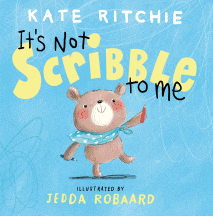
It’s Not Scribble to Me
It’s Not Scribble to Me
Kate Ritchie
Jedda Robaard
Puffin Books, 2018
32pp., hbk., RRP $A19.99
9780143790136
Little Teddy loves to draw – crayons, paints, pencils, even stencils (and the permanent markers if he can reach them) are all his favourite tools of trade. But while paper is nice, it’s not big enough to hold all of his drawings and so he uses other nearby surfaces like the wall,the bathroom tiles and even the toilet seat lid -wherever the colour takes his imagination. Like most parents, his parents get annoyed at having to continually clean up but Teddy doesn’t see his work as scribble. Each one is a personal masterpiece inspired by his surroundings and begs them to understand that his marks are the “colourful, magical, bountiful, beautiful, whimsical, wonderful world” in his head.
On the surface, this is a fun book that will be a familiar scenario for many preschoolers, written in rhyme to engage them and perhaps even consolidate their knowledge of colours. Its theme will resonate with many parents and they might even have discussions about what else Teddy could have drawn that was green, red, yellow or black.
But it is also a very useful tool to teach slightly older readers about perspective – that what one sees as beautiful artworks, another sees as scribble and vice versa. Little children are still very much in the world of the here and now and what they can see, so to start to view things from another’s perspective is a critical step in their development, particularly as they also have a very strong sense of justice and what’s fair. Taking someone’s pencil without asking may be seen as “theft” by one little one, while really it’s just using something that’s needed and available by another one used to sharing without asking.
Little Miss Muffet might have been frightened by the spider, but how did the spider feel about her sitting right where he was in the process of building his web?
Little Boy Blue probably shouldn’t have fallen asleep while he was supposed to be watching the sheep, but what if he had been up all night helping a little lamb be born?
Seeing another’s point of view is an essential element of the development of Ethical Understanding and it’s not too early to start our littlies thinking about the perspectives of those around them, perhaps even exploring the old adage that “there are always two sides to a story.”
